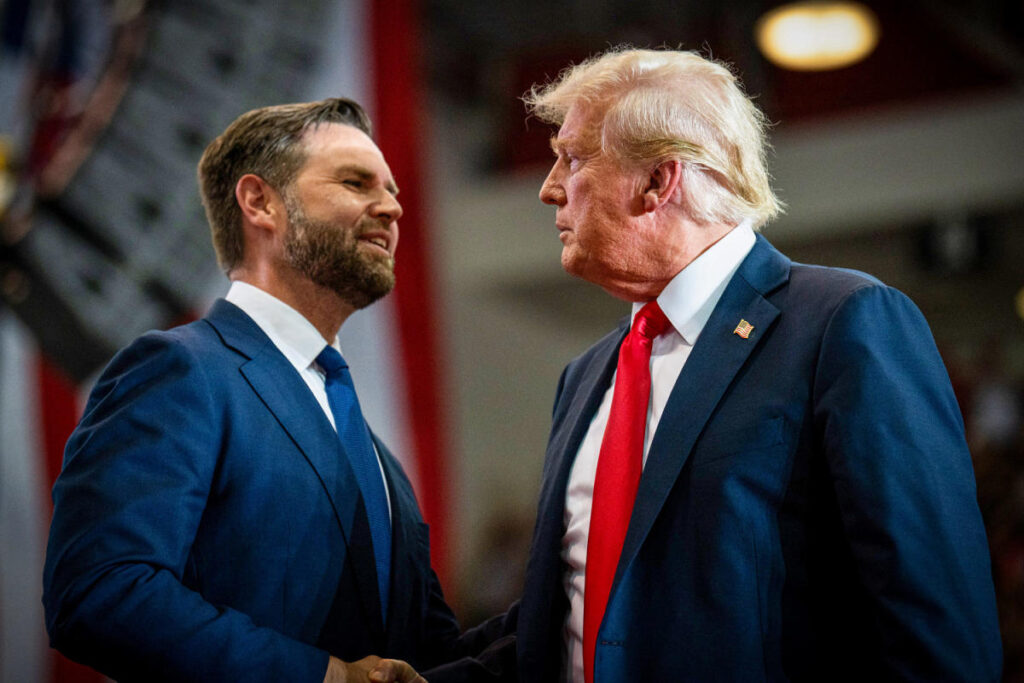In the latest edition of the NBC News Politics team’s newsletter, key themes in the 2024 election campaign are explored, focusing particularly on JD Vance’s role in articulating Donald Trump’s controversial remarks and the strategies of both Trump and Kamala Harris as the campaign nears its conclusion. Senior national political reporter Henry Gomez and campaign embed Alec Hernández highlight how Vance, a prominent figure in Trump’s campaign, attempts to clarify and contextualize Trump’s often inflammatory statements. Instead of evading questions like many GOP members do, Vance takes on the unofficial title of “explainer-in-chief,” often aligning himself closely with Trump’s messaging while reframing reactions to Trump’s rhetoric. This approach marks a significant shift for Vance, who was once critical of Trump, demonstrating a commitment to the former president’s controversial narrative.
As the election approaches, the anticipation surrounding Trump’s potential early declaration of victory is palpable. Reports from NBC News indicate that both Kamala Harris’s team and some Trump allies expect Trump to assert a win on election night, regardless of the actual vote count. In battleground states where ballots may take time to tally, this scenario mirrors the challenges and tensions experienced during the 2020 election. Notably, aides to Harris, along with the vice president herself, express preparedness for the chaotic aftermath should Trump resort to such a declaration. Harris emphasizes the importance of recognizing Trump’s past actions, including attempts to undermine a legitimate election outcome and inciting violence, underscoring her campaign’s readiness to address this potential crisis head-on.
Chuck Todd, NBC’s chief political analyst, reflects on the comparatively conventional nature of the closing arguments being put forth by both campaigns amidst such a tumultuous political climate. After the unconventional and often tumultuous races of 2016 and 2020, Todd observes that the 2024 campaign feels more streamlined, with both candidates focusing on persuading undecided voters—particularly Republicans or Republican-leaning independents who may harbor reservations about Trump while questioning Harris’s more liberal stances. The emphasis is now on the battleground states, and both campaigns tailor their messages to attract these crucial voters around key issues of character, policy, and stability, signaling a shift toward traditional campaigning strategies as Election Day draws near.
Moreover, recent campaign activities illustrate the stark contrasts between the candidates. While Harris actively counters Trump’s incendiary comments by labeling him as “increasingly unhinged” and challenging his character, Trump, in turn, resorts to crude personal attacks on Harris, attempting to depict her as inept and out of touch. These exchanges highlight the escalating negative campaigning that underscores the election, as both candidates strive to galvanize their bases while also courting undecided voters. This back-and-forth underscores the intensity of the battle for public perception and voter support, especially as the elected officials navigate the increasingly polarized political landscape.
Additionally, legal challenges surrounding the election process loom large, with nearly 100 lawsuits filed primarily by Republican groups aimed at shaping how votes will be cast and counted in key battleground states. The Harris campaign anticipates these developments and expresses readiness to confront any challenges raised by Trump’s campaign. Such legal skirmishes reflect a larger strategy deployed by both parties to secure their electoral advantages, further complicating the road to Election Day and indicating the tense atmosphere that is likely to permeate the electoral process.
In terms of their final outreach, Harris’s campaign is launching an aggressive initiative targeting young voters on college campuses, showcasing an innovative approach that combines social events and substantial social media outreach. This effort includes robust advertising targeting students, signifying the importance of mobilizing younger demographics in an increasingly digital age. Meanwhile, Trump’s campaign continues to rely on more traditional alignments with conservative voters, using provocative statements to rally his base. As the campaigns draw to a close, the landscape remains charged, with both candidates prioritizing their messaging and outreach strategies amid a backdrop of heightened tensions, competitive legal battles, and the unique dynamics introduced by their differing approaches to the electorate.
As the newsletter concludes, it is evident that the political climate surrounding the 2024 election is both unpredictable and contentious. With Vance stepping into a central role in defending Trump, expectations surrounding potential election night proclamations of victory, and the calculated tactics employed by both Harris and Trump to sway undecided voters, the final days leading up to the election promise to be fraught with challenges. Political analysts and voters alike remain vigilant, aware that any number of unforeseen developments could reshape the trajectory of the election. The overarching narrative underscores the complex interplay of strategy, messaging, and voter engagement that will ultimately determine the election’s outcome in November.

